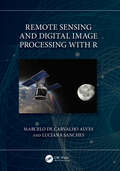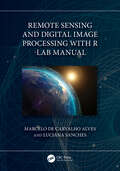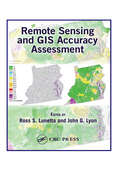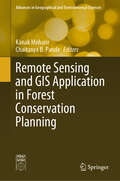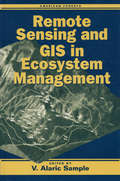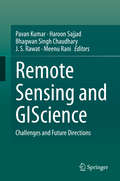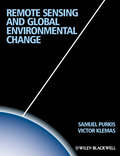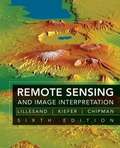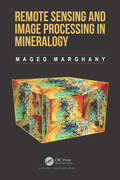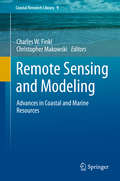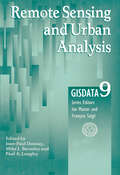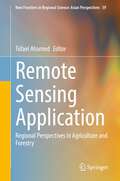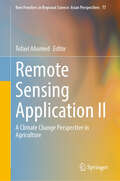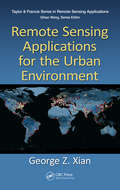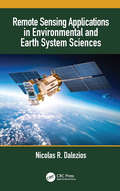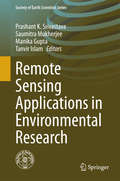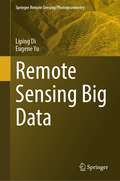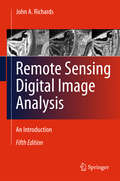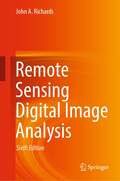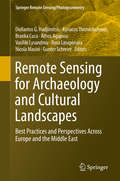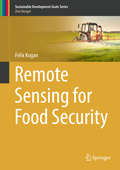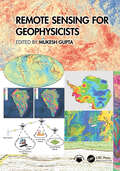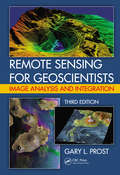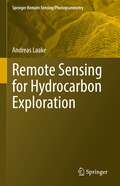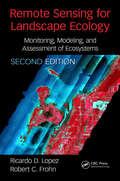- Table View
- List View
Remote Sensing and Digital Image Processing with R
by Marcelo de Carvalho Alves Luciana SanchesThis new textbook on remote sensing and digital image processing of natural resources includes numerous, practical problem-solving exercises and applications of sensors and satellite systems using remote sensing data collection resources, and emphasizes the free and open-source platform R. It explains basic concepts of remote sensing and multidisciplinary applications using R language and R packages, by engaging students in learning theory through hands-on, real-life projects. All chapters are structured with learning objectives, computation, questions, solved exercises, resources, and research suggestions. Features Explains the theory of passive and active remote sensing and its applications in water, soil, vegetation, and atmosphere. Covers data analysis in the free and open-source R platform, which makes remote sensing accessible to anyone with a computer. Includes case studies from different environments with free software algorithms and an R toolset for active learning and a learn-by-doing approach. Provides hands-on exercises at the end of each chapter and encourages readers to understand the potential and the limitations of the environments, remote sensing targets, and process. Explores current trends and developments in remote sensing in homework assignments with data to further explore the use of free multispectral remote sensing data, including very high spatial resolution data sources for target recognition with image processing techniques. While the focus of the book is on environmental and agriculture engineering, it can be applied widely to a variety of subjects such as physical, natural, and social sciences. Students in upper-level undergraduate or graduate programs, taking courses in remote sensing, geoprocessing, civil and environmental engineering, geosciences, environmental sciences, electrical engineering, biology, and hydrology will also benefit from the learning objectives in the book. Professionals who use remote sensing and digital processing will also find this text enlightening.
Remote Sensing and Digital Image Processing with R - Lab Manual
by Marcelo de Carvalho Alves Luciana SanchesThis Lab Manual is a companion to the textbook Remote Sensing and Digital Image Processing with R. It covers examples of natural resource data analysis applications including numerous, practical problem-solving exercises, and case studies that use the free and open-source platform R. The intuitive, structural workflow helps students better understand a scientific approach to each case study in the book and learn how to replicate, transplant, and expand the workflow for further exploration with new data, models, and areas of interest. Features Aims to expand theoretical approaches of remote sensing and digital image processing through multidisciplinary applications using R and R packages. Engages students in learning theory through hands-on real-life projects. All chapters are structured with solved exercises and homework and encourage readers to understand the potential and the limitations of the environments. Covers data analysis in the free and open-source R platform, which makes remote sensing accessible to anyone with a computer. Explores current trends and developments in remote sensing in homework assignments with data to further explore the use of free multispectral remote sensing data, including very high spatial resolution information. Undergraduate- and graduate-level students will benefit from the exercises in this Lab Manual, because they are applicable to a variety of subjects including environmental science, agriculture engineering, as well as natural and social sciences. Students will gain a deeper understanding and first-hand experience with remote sensing and digital processing, with a learn-by-doing methodology using applicable examples in natural resources.
Remote Sensing and GIS Accuracy Assessment
by Ross S. Lunetta John G. LyonBased upon a special symposium sponsored by the U.S. Environmental Protection Agency (EPA), Remote Sensing and GIS Accuracy Assessment evaluates the important scientific elements related to the performance of accuracy assessments for remotely sensed data, GIS data analysis, and integration products. Scientists from federal, state, and local governments, academia, and nongovernmental organizations present technical papers which examine sampling issues, reference data collection, edge and boundary effects, error matrix and fuzzy assessments, error budget analysis, and change detection accuracy assessment. This compilation contains 20 chapters that represent important symposium outcomes.
Remote Sensing and GIS Application in Forest Conservation Planning (Advances in Geographical and Environmental Sciences)
by Kanak Moharir Chaitanya B. PandeThis book focuses on the challenges in conservation, management and protection of forests in India as well as other countries, using recently developed technologies. Various topics are discussed including remote sensing, GIS, land use land cover, forest conservation techniques, social economics effects, fire forecasting models and the effect of fire on natural resources, among others. The book provides multi-disciplinary overviews for academicians, administrators, policymakers and professionals involved in the diverse aspects of sustainable forest development, planning and management, and forecasting and extinguishing forest fires. The book helps readers better understand the development of forests by planning and management in India and other countries, with the following focuses: - Forest area conservation in India and other countries - Advanced techniques for planning and conservation of forest cover - Forest conservation modeling using remote sensing and GIS techniques - Forest fire forecasting models used in remote sensing and GIS environments
Remote Sensing and GIS in Ecosystem Management
by Al SampleRecent advances in remote-sensing technology and the processing of remote-sensing data through geographic information systems (GIS) present ecologists and resource managers with a tremendously valuable tool -- but only if they are able to understand its capabilities and capture its potential.Remote Sensing and GIS in Ecosystem Management identifies and articulates current and emerging information needs of those involved with the management of forest ecosystems. It explores the potential of remote-sensing/GIS technologies to address those needs, examining: the need for landscape-scale analysis to support forest ecosystem research and management current challenges in the development of remote-sensing/GIS applications case studies of different forest regions in the United States the potential for further development or declassification of military and aerospace remote-sensing/GIS technologies As well as providing important information for ecologists and resource managers, the book will serve as a valuable resource for legislative and judicial policymakers who do not have a technical background in either remote sensing or resource management but who are nonetheless called upon to make decisions regarding the protection and management of forest ecosystems.
Remote Sensing and GIScience: Challenges and Future Directions
by Pavan Kumar Haroon Sajjad Bhagwan Singh Chaudhary J. S. Rawat Meenu RaniThis book covers several themes related to forestry, agriculture, water, soil, urban, and atmospheric research. GIScience technology systems have increased in significance in recent decades and have the ability to acquire information at ground level with a higher spectral resolution using a field radio-spectrometer, which is a great improvement compared to other remote sensing systems. GIScience technology systems are widely used for solving and understanding the concept of forestry, crop, water resources, and related research themes. This book aims to advance the scientific understanding of GIScience technology and applications. The chapters present GIScience data integration with other sources such as LiDAR, Multi-spectral data and their applications in forestry, crop assessment, soil assessment, mineral mapping and related themes. The book will be of interest to geospatial experts, modellers, foresters, agricultural scientists, hyperspectral remote sensing and space community, ecologists and conservation communities, environmental consultants, big data compilers, and computing experts.
Remote Sensing and Global Environmental Change
by Sam J. Purkis Victor V. KlemasRemote Sensing plays a key role in monitoring the various manifestations of global climate change. It is used routinely in the assessment and mapping of biodiversity over large areas, in the monitoring of changes to the physical environment, in assessing threats to various components of natural systems, and in the identification of priority areas for conservation.This book presents the fundamentals of remote sensing technology, but rather than containing lengthy explanations of sensor specifications and operation, it concentrates instead on the application of the technology to key environmental systems. Each system forms the basis of a separate chapter, and each is illustrated by real world case studies and examples. ReadershipThe book is intended for advanced undergraduate and graduate students in earth science, environmental science, or physical geography taking a course in environmental remote sensing. It will also be an invaluable reference for environmental scientists and managers who require an overview of the use of remote sensing in monitoring and mapping environmental change at regional and global scales.Additional resources for this book can be found at: http://www.wiley.com/go/purkis/remote.
Remote Sensing and Image Interpretation (6th Edition)
by Thomas M. Lillesand Ralph W. Kiefer Jonathan W. ChipmanThis book can be used in two ways: as a textbook in introductory courses in remote sensing and image interpretation, and as a reference for the burgeoning number of practitioners who use geospatial information and analysis in their work.
Remote Sensing and Image Processing in Mineralogy
by Maged MarghanyRemote Sensing and Image Processing in Mineralogy reveals the critical tools required to comprehend the latest technology surrounding the remote sensing imaging of mineralogy, oil and gas explorations. It particularly focusses on multispectral, hyperspectral and microwave radar, as the foremost sources to understand, analyze and apply concepts in the field of mineralogy. Filling the gap between modern physics quantum theory and image processing applications of remote sensing imaging of geological features, mineralogy, oil and gas explorations, this reference is packed with technical details associated with the potentiality of multispectral, hyperspectral and synthetic aperture radar (SAR). The book also includes key methods needed to extract the value-added information necessary, such as lineaments, gold and copper minings. This book also reveals novel speculation of quantum spectral mineral signature identifications, named as quantized Marghany’s mineral spectral or Marghany Quantum Spectral Algorithms for Mineral identifications (MQSA). Rounding out with practical simulations of 4-D open-pit mining identification and monitoring using the hologram radar interferometry technique, this book brings an effective new source of technology and applications for today’s minerology and petroleum engineers. Key Features• Helps develop new algorithms for retrieving mineral mining potential zones in remote sensing data.• Solves specific problems surrounding the spectral signature libraries of different minerals in multispectral and hyperspectral data.• Includes over 200 equations that illustrate how to follow examples in the book.
Remote Sensing and Modeling
by Charles W. Finkl Christopher MakowskiThis book is geared for advanced level research in the general subject area of remote sensing and modeling as they apply to the coastal marine environment. The various chapters focus on the latest scientific and technical advances in the service of better understanding coastal marine environments for their care, conservation and management. Chapters specifically deal with advances in remote sensing coastal classifications, environmental monitoring, digital ocean technological advances, geophysical methods, geoacoustics, X-band radar, risk assessment models, GIS applications, real-time modeling systems, and spatial modeling. Readers will find this book useful because it summarizes applications of new research methods in one of the world's most dynamic and complicated environments. Chapters in this book will be of interest to specialists in the coastal marine environment who deals with aspects of environmental monitoring and assessment via remote sensing techniques and numerical modeling.
Remote Sensing and Urban Analysis: GISDATA 9
by Jean–Paul Donnay Michael J. Barnsley Paul A. LongleyOne of the key geographical developments over the last two centuries has been that of urbanisation. In recent years this has exploded globally, particularly in developing countries. It is essential for governments, planners and researchers in geography and allied fields to understand this process and the main way of being able to do this is to accu
Remote Sensing Application: Regional Perspectives in Agriculture and Forestry (New Frontiers in Regional Science: Asian Perspectives #59)
by Tofael AhamedThis book focuses solely on the issues of agriculture and forest productivity analysis with advanced modeling approaches to bring solutions to food-insecure regions of South and Southeast Asia. Advanced modeling tools and their use in regional planning provide an outstanding opportunity to contribute toward food production and environments. In this book, leading-edge research methodologies related to remote sensing and geospatial variability of soil, water, and regional agricultural production indicators and their applications are introduced together—a unique feature of the book is the domain of regional policy perspectives and allied fields. In regional policy planning, agriculture and forestry have a key role in food security and environmental conservation that depends on the geo-spatial variability of these factors. Over the years, nature and climate have determined the variability of soil type, soil quality, geographical deviation for habitat, water quality, water sources, urban influences, population growth, carbon stock levels, and water resources with rain-fed or irrigated land use practices. In addition, human nutritional values and dietary habits have brought cultural adaptation of either mono- or multi-cropping patterns in the region. To encompass all these above mentioned factors and classify regional variability for policy planning, satellite remote sensing and geographical information systems have the immense potential to increase agricultural and forest productivity to ensure the resilience of its sustainability. Therefore, the 13 chapters presented in this book introduce modeling techniques using the signatures of vegetation and water indices, land use and land change dynamics, climatic, and socioeconomic criteria through spatial, temporal, and statistical analysis. As well, remote sensing and in-depth GIS analysis are integrated with machine and deep learning algorithms to address natural uncertainties such as flash floods, droughts, and cyclones in agricultural production management.
Remote Sensing Application II: A Climate Change Perspective in Agriculture (New Frontiers in Regional Science: Asian Perspectives #77)
by Tofael AhamedThis book focuses solely on the issues of agricultural productivity analysis with advanced modeling approaches bringing solutions to food-insecure regions of the world, especially in south and southeast Asia and in Africa. Advanced modeling tools and their use in regional planning provide an outstanding opportunity to help face the challenges of climate change. The sudden effect of flash floods, drought, salinity, and sea water rises causing saltwater intrusions and its impact on agricultural production are some of the disastrous results of climate change. In this edited volume, information on climate-induced impacts for flooding, flash floods, and drought impact on agricultural crops is provided to address possible solutions for food security in south Asia, southeast Asia, and some regions of Africa. Leading-edge research methodology is presented as it relates to remote sensing applications for regional science and allied fields. In regional policy planning, agriculture andforestry play key roles in food security along with environmental conservation and depend on geo-spatial variability. Satellite remote sensing and geographical information systems have an immense potential to encompass all these factors and to catalogue the regional variability of climate change and climate economics. In the satellite remote sensing domain, advanced modeling tools, deep learning applications, and cloud-based earth engines significantly increase the flexibility of decision making and its application for regional perspectives. The result can increase agricultural and forest productivity and ensure its resilience and sustainability. The book’s chapters introduce modeling techniques such as machine learning and fuzzy expert system using satellite remote sensing datasets based on cloud application. These methods assist regional planners to increase crop production, land use, and detection of changes in land cover in order to better understand their vulnerability toclimate-related disaster. Furthermore, remote sensing and in-depth GIS analysis are integrated with machine learning to address natural uncertainties such as flash floods, droughts, and cyclones so that emergency responses for agricultural production management can be adopted more effectively.
Remote Sensing Applications for the Urban Environment (Remote Sensing Applications Ser. #12)
by George Z. XianLand use and land cover changes associated with increased urbanization have led to landscape and environmental changes throughout the world. Remote Sensing Applications for the Urban Environment places emphasis on the rapid development of worldwide urbanization and its impact on the environment, and reviews the assessment of urban land cover condit
Remote Sensing Applications in Environmental and Earth System Sciences
by Nicolas R. DaleziosRemote Sensing Applications in Environmental and Earth System Sciences is a contemporary, multi-disciplinary, multi-scaling, updated, and upgraded approach of applied remote sensing in the environment. The book begins with an overview of remote sensing technology, and then explains the types of data that can be used as well as the image processing and analysis methods that can be applied to each type of application through the use of case studies throughout. Includes a wide spectrum of environmental applications and issues Explains methodological image analysis and interpretation procedures for conducting a variety of environmental analyses Discusses the development of early warning systems Covers monitoring of the environment as a whole – atmosphere, land, and water Explores the latest remote sensing systems in environmental applications This book is an excellent resource for anyone who is interested in remote sensing technologies and their use in Earth systems, natural resources, and environmental science.
Remote Sensing Applications in Environmental Research
by Prashant K. Srivastava Saumitra Mukherjee Manika Gupta Tanvir IslamRemote Sensing Applications in Environmental Research is the basis for advanced Earth Observation (EO) datasets used in environmental monitoring and research. Now that there are a number of satellites in orbit, EO has become imperative in today's sciences, weather and natural disaster prediction. This highly interdisciplinary reference work brings together diverse studies on remote sensing and GIS, from a theoretical background to its applications, represented through various case studies and the findings of new models. The book offers a comprehensive range of contributions by well-known scientists from around the world and opens a new window for students in presenting interdisciplinary and methodological resources on the latest research. It explores various key aspects and offers state-of-the-art research in a simplified form, describing remote sensing and GIS studies for those who are new to the field, as well as for established researchers.
Remote Sensing Big Data (Springer Remote Sensing/Photogrammetry)
by Liping Di Eugene YuThis monograph provides comprehensive coverage of the collection, management, and use of big data obtained from remote sensing. The book begins with an introduction to the basics of big data and remote sensing, laying the groundwork for the more specialized information to follow. The volume then goes on to address a wide variety of topics related to the use and management of remote sensing big data, including hot topics such as analysis through machine learning, cyberinfrastructure, and modeling. Examples on how to use the results of big data analysis of remotely sensed data for concrete decision-making are offered as well. The closing chapters discuss geospatial big data initiatives throughout the world and future challenges and opportunities for remote sensing big data applications. The audience for this book includes researchers at the intersection of geoscience and data science, senior undergraduate and graduate students, and anyone else interested in how large datasets obtained through remote sensing can be best utilized. The book presents a culmination of 30 years of research from renowned spatial scientists Drs. Liping Di and Eugene Yu.
Remote Sensing Digital Image Analysis
by John A. RichardsRemote Sensing Digital Image Analysis provides the non-specialist with an introduction to quantitative evaluation of satellite and aircraft derived remotely retrieved data. Since the first edition of the book there have been significant developments in the algorithms used for the processing and analysis of remote sensing imagery; nevertheless many of the fundamentals have substantially remained the same. This new edition presents material that has retained value since those early days, along with new techniques that can be incorporated into an operational framework for the analysis of remote sensing data. The book is designed as a teaching text for the senior undergraduate and postgraduate student, and as a fundamental treatment for those engaged in research using digital image processing in remote sensing. The presentation level is for the mathematical non-specialist. Since the very great number of operational users of remote sensing come from the earth sciences communities, the text is pitched at a level commensurate with their background. Each chapter covers the pros and cons of digital remotely sensed data, without detailed mathematical treatment of computer based algorithms, but in a manner conductive to an understanding of their capabilities and limitations. Problems conclude each chapter.
Remote Sensing Digital Image Analysis
by John A. RichardsRemote Sensing Digital Image Analysis provides a comprehensive treatment of the methods used for the processing and interpretation of remotely sensed image data. Over the past decade there have been continuing and significant developments in the algorithms used for the analysis of remote sensing imagery, even though many of the fundamentals have substantially remained the same. As with its predecessors this new edition again presents material that has retained value but also includes newer techniques, covered from the perspective of operational remote sensing. The book is designed as a teaching text for the senior undergraduate and postgraduate student, and as a fundamental treatment for those engaged in research using digital image analysis in remote sensing. The presentation level is for the mathematical non-specialist. Since the very great number of operational users of remote sensing come from the earth sciences communities, the text is pitched at a level commensurate with their background. The chapters progress logically through means for the acquisition of remote sensing images, techniques by which they can be corrected, and methods for their interpretation. The prime focus is on applications of the methods, so that worked examples are included and a set of problems conclude each chapter.
Remote Sensing for Archaeology and Cultural Landscapes: Best Practices and Perspectives Across Europe and the Middle East (Springer Remote Sensing/Photogrammetry)
by Nicola Masini Rosa Lasaponara Diofantos G. Hadjimitsis Kyriacos Themistocleous Branka Cuca Athos Agapiou Vasiliki Lysandrou Gunter SchreierThis book investigates the added value that satellite technologies and remote sensing could provide for a more sustainable mapping, monitoring and management of heritage sites, be it for purposes of regular maintenance or for risk mitigation in case of natural or man-caused hazards. One of the major goals of this book is to provide a clear overview on policy perspectives, regarding both space policy as well as heritage policy, and to provide possible suggestions for common ground of these two fields, in Europe and around the world. Readers will develop a good understanding of cutting-edge applications of remote sensing and geographic information science, and the challenges that affect heritage maintenance and protection. Particular attention is given to Earth observation and remote sensing techniques applied in different locations. This book brings together innovative technologies, concrete applications and policy perspectives that can lead to a more complete vision of cultural heritage as a resource for future development of our society as a whole.
Remote Sensing for Food Security (Sustainable Development Goals Series)
by Felix KoganThis volume gathers a variety of applications for remote sensing of vegetation health (VH) and concretely shows how this information can be used in service of ending hunger and of ensuring future food security. In this book’s ten chapters, Dr. Felix Kogan, one of the most prolific scientists in this sphere, shows how a new VH method, designed from operational environmental satellite data, can be used to provide advanced predictions of agricultural losses, helping to enhance food security and reducing the number of hungry people. Topics covered include the scientific basis of the VH method, drought monitoring, prediction of short-term agricultural yield and crop insurance, and impacts of long term climate variability and change on food security. A short discussion on VH for human health-related topics such as detection and prediction of malaria and fire risk is included as well.
Remote Sensing for Geophysicists
by Mukesh GuptaGeophysical exploration methods are very expensive and invasive methods for surveys. Remote sensing methods are non-invasive and much cheaper for investigating the Earth’s surface. This book bridges this gap and aims to integrate exploration geophysics with remote sensing as a cost-effective method which is easy to implement for prospecting in different areas. It provides exploration geophysicists with the necessary information to use advanced remote sensing technology in the exploration of oil and gas, minerals, and groundwater. It describes the integration of remote sensing in each of the nine exploration methods based on over 11 case studies from different countries across the globe.Features: Describes the geophysical exploration methods that geophysicists frequently use, along with suitable remote sensing techniques Offers a well-structured one-stop guide for finding a suitable remote sensing technique for a specific geophysical exploration method Provides case studies on the exploration of oil, gas, and groundwater with step-by-step instructions using remote sensing technology Serves as a practical field book for exploration geophysicists who never used or rarely use remote sensing. Enables exploration geophysicists to understand and interpret remote sensing data for the assessment of complex explorations This book is an excellent resource for professionals, researchers, academics, and students with a background in remote sensing across many disciplines in Earth sciences such as geology, hydrology, petrology, mining, geography, geosciences, etc.
Remote Sensing for Geoscientists: Image Analysis and Integration, Third Edition
by Gary L. ProstThis third edition of the bestselling Remote Sensing for Geologists: A Guide to Image Interpretation is now titled Remote Sensing for Geoscientists: Image Analysis and Integration. The title change reflects that this edition applies to a broad spectrum of geosciences, not just geology; stresses that remote sensing has become more than photointerpre
Remote Sensing for Hydrocarbon Exploration (Springer Remote Sensing/Photogrammetry)
by Andreas LaakeThis book provides insights into the benefits of using remote sensing data from a geoscientist's perspective, by integrating the data with the understanding of Earth's surface and subsurface. In 3 sections, the book takes a detailed look at what data explorationists use when they explore for hydrocarbon resources, assess different terrain types for planning and hazards and extract present-day geologic analogs for subsurface geologic settings. The book presents the usage of remote sensing data in exploration in a structured way by detecting individual geologic features as building blocks for complex geologic systems. This concept enables readers to build their own workflows for the assessment of complex geologic systems using various combinations of remote sensing data. Section 1 introduces readers to the foundations of remote sensing for exploration, covers various methods of image processing and studies different digital elevation and bathymetry models. Section 2 presents the concept of geomorphology as a means to integrate surface and subsurface data. Different aspects of rendering in 2D and 3D are explained and used for the interpretation and extraction of geologic features that are used in exploration.Section 3 addresses remote sensing for hydrocarbon exploration in detail, from geophysical data acquisition to development and infrastructure planning. The organization of this chapter follows an exploration workflow from regional to local modeling studying basin and petroleum system modeling as well as logistics planning of seismic surveys and near-surface modeling. Aspects of field development and infrastructure planning comprise multi-temporal and dynamic modeling. The section closes with a structured approach to extracting geologic analogs from interpreted remote sensing data.The book will be of interest to professionals and students working in exploration for hydrocarbons and water resources, as well as geoscientists and engineers using remote sensing for infrastructure planning, hazard assessment and dynamic environmental studies.
Remote Sensing for Landscape Ecology: Monitoring, Modeling, And Assessment Of Ecosystems
by Ricardo D Lopez Robert C FrohnThis book provides the practical basis for the use of remote sensing to accomplish landscape ecological projects, through the merging of theory and practice, with examples. This is a specialized application and both these topics have evolved rapidly in the past decade. This evolution is not in the previous edition, and indeed this update provides much new information and valuable ideas for the professional and assist in directing the training of new personnel. The new edition will feature a combination of landscape ecology metrics, quantitative field measurements, and geospatial analyses.
